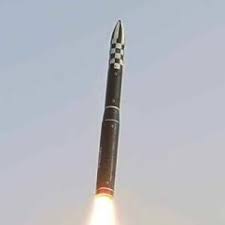Hwasong-18: Intercontinental Ballistic Missile

North Korea recently tested its latest Hwasong-18 intercontinental ballistic missile (ICBM).
- Hwasong-18 is a type of solid-fuel intercontinental ballistic missile (ICBM) developed by North Korea.
- It is North Korea’s first ICBM to use solid-fuel, which allows for faster launches.
- Liquid propellants provide greater propulsive thrust and power, but require more complex technology and extra weight.
- Solid fuel is dense and burns quite quickly, generating thrust over a short time.
- Solid fuel can remain in storage for an extended period without degrading or breaking down – a common issue with liquid fuel.
- Solid-fuel missiles are easier and safer to operate, and require less logistical support, making them harder to detect and more survivable than liquid-fuel weapons.
- Ballistic Missile is a rocket-propelled self-guided strategic-weapons system that follows a ballistic trajectory to deliver a payload from its launch site to a predetermined target.
- Ballistic missiles are powered initially by a rocket or series of rockets in stages, but then follow an unpowered trajectory that arches upwards before descending to reach its intended target.




